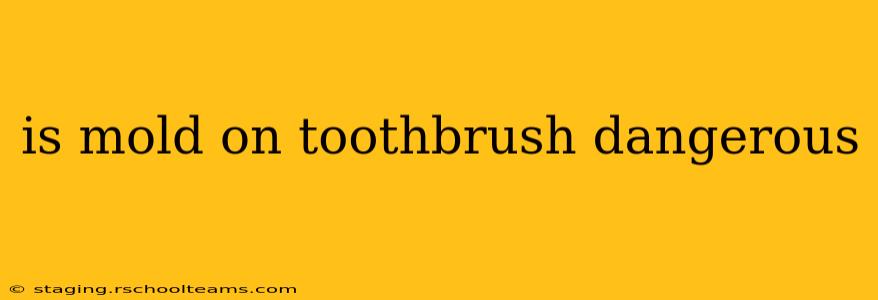Finding mold on your toothbrush is undeniably unsettling. The question isn't just is it dangerous, but how dangerous is it, and what should you do about it? This comprehensive guide delves into the risks associated with moldy toothbrushes, providing you with the information you need to protect your oral health.
What Does Mold on a Toothbrush Look Like?
Mold can manifest in various ways on a toothbrush. You might notice fuzzy, slimy patches, discoloration (often black, green, or gray), or a musty odor emanating from the bristles. Even if you don't see visible mold, a persistent unpleasant smell could indicate a hidden problem. The type of mold present will vary depending on your environment and the humidity levels in your bathroom.
Is Mold on a Toothbrush Harmful?
Yes, mold on a toothbrush can be harmful. Mold spores are microscopic, and inhaling them can trigger allergic reactions in susceptible individuals, leading to symptoms like sneezing, coughing, watery eyes, and skin irritation. More significantly, ingesting mold through a contaminated toothbrush can potentially lead to gastrointestinal issues. The specific health risks depend on the type of mold, the amount of exposure, and individual sensitivities. Some molds produce mycotoxins, which are toxic compounds that can pose more serious health risks.
What Types of Mold Are Commonly Found on Toothbrushes?
Several mold species thrive in damp bathroom environments, where toothbrushes are often stored. Common culprits include Aspergillus, Penicillium, and Cladosporium. Identifying the specific species requires laboratory testing, which is typically not necessary unless you experience severe symptoms. The crucial point is that any type of mold poses a potential health risk.
What Should I Do If I Find Mold on My Toothbrush?
Don't hesitate! Immediately discard the moldy toothbrush. Do not attempt to clean and reuse it. The mold is likely embedded within the bristles and difficult to remove completely. Replace it with a brand new toothbrush.
How Can I Prevent Mold Growth on My Toothbrush?
Preventing mold is far easier than dealing with the consequences. Here are some essential steps:
- Proper Storage: Store your toothbrush upright in a well-ventilated area, away from direct contact with water. A toothbrush holder with good drainage is ideal. Avoid closed containers that trap moisture.
- Regular Cleaning: Rinse your toothbrush thoroughly after each use. Consider periodically cleaning it with a mild antibacterial mouthwash.
- Replace Regularly: Replace your toothbrush every 3-4 months or sooner if the bristles become frayed or damaged.
- Bathroom Ventilation: Ensure adequate ventilation in your bathroom. Use an exhaust fan during and after showering to reduce humidity levels.
- Clean Your Bathroom Regularly: Maintain a clean and dry bathroom environment to discourage mold growth. Regularly clean surfaces and remove any standing water.
Can I Clean a Moldy Toothbrush and Reuse It?
No. While some suggest cleaning a moldy toothbrush with bleach or other disinfectants, it's not recommended. The porous nature of toothbrush bristles makes complete mold removal virtually impossible. The risk of residual mold and potential health consequences outweighs any attempts to salvage a contaminated toothbrush. Replacing it is the safest and most effective approach.
What are the long-term effects of using a moldy toothbrush?
Long-term effects of using a moldy toothbrush are not definitively established through extensive studies. However, repeated exposure to mold spores through a contaminated toothbrush might lead to the development of allergies, respiratory problems, or even more severe health issues in individuals with compromised immune systems. The safest practice is always preventative—discard and replace immediately.
By following these preventive measures and acting swiftly when you find mold, you can significantly reduce the risk of experiencing any health issues related to mold contamination on your toothbrush. Remember, prioritizing your oral and overall health is paramount.
